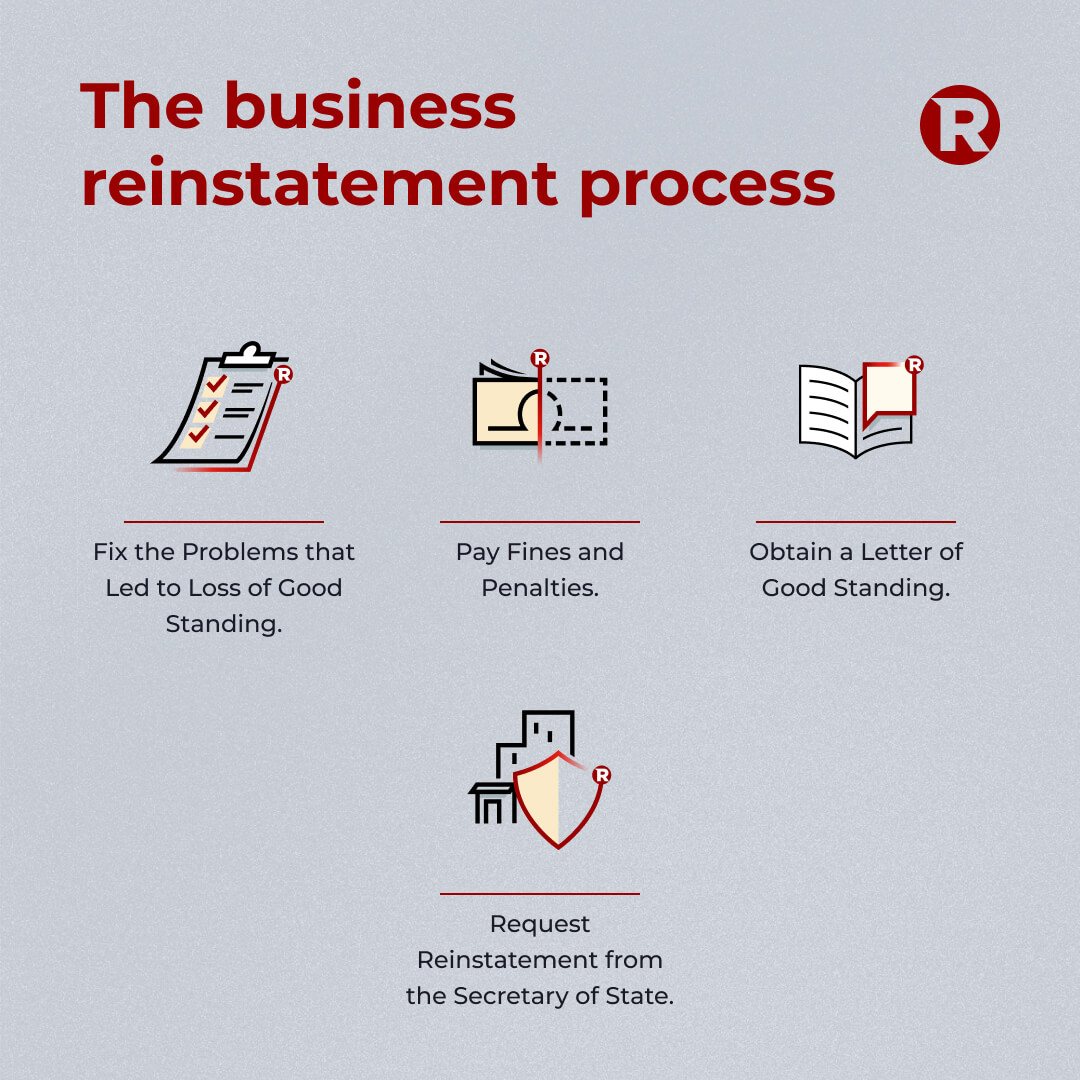What is reinstatement?
Reinstatement restores a business to good standing. Learn why businesses lose good standing and the process to get reinstated with the Secretary of State.

Reinstatement is the process of bringing a business entity back into good standing with the state. A company that is not in good standing cannot conduct business within the state, and the owners lose their liability protections.
Loss of good standing occurs when a business does not meet certain legal obligations. A reinstated business returns to the position it was in before the loss of good standing. The process can be as simple as filing documents and paying taxes to bring the business into compliance, then requesting reinstatement.
What is Business Reinstatement?
Reinstatement returns a business to good standing, which allows it to engage in a full range of legal business activities. These include transacting business in the state, appearing in court as a distinct legal entity, and shielding its owners from personal liability for business debts.
A business can lose good standing for failing to fulfill obligations under state law. While specific reasons vary by state, common reasons include:
- Failing to file information reports.
- Failing to pay franchise tax, also referred to as annual report fee or privilege tax, or failing to file its returns.
- Failing to maintain a registered agent in the state.

When a business fails to comply with certain state laws, the state may take several actions:
- Notice: The Secretary of State will send a notice identifying the problem, often with a deadline to fix it.
- Suspension or forfeiture: If the business misses the deadline, the Secretary of State will revoke, cancel, suspend, or forfeit the business’s legal right to operate in the state. The business must fix the problems and seek reinstatement to continue operating.
- Administrative dissolution: Continued failure to bring the business into compliance may result in dissolution by the Secretary of State. Reinstatement might still be possible, but not in all cases. It’s important to note that reinstatement is typically available for a limited period after dissolution.
When Is Reinstatement Required?
Not every business that has lost good standing needs to seek reinstatement—but it depends on how and why the business was dissolved. A voluntary dissolution happens when the owners intentionally close the business and properly wind up its affairs, which typically ends future liability once all obligations are settled. In contrast, an administrative dissolution happens when the state dissolves the business automatically, often for failing to file reports or pay fees.
If a business continues to operate after an administrative dissolution, it may lose its limited liability protection, meaning the owners could become personally responsible for debts or legal claims. Businesses that are still active or plan to resume operations should usually seek reinstatement to restore that protection and maintain compliance.
Reinstatement to Resume Doing Business
Suspension, forfeiture, or administrative dissolution stops a business from legally operating. If the business plans to continue, it must seek reinstatement.
A business that is not in good standing with the state cannot engage in many activities, even before administrative dissolution occurs:
- Borrowing money: Banks generally consider such businesses too risky for loans or lines of credit.
- Attracting investors: Investors tend to avoid businesses that have lost good standing.
- Bringing claims in court: Some states only allow business entities in good standing to file suit or appear in court.
- Maintaining license and permits: Loss of good standing could interfere with obtaining or renewing necessary permits or licenses.
- Expanding to new states: Many states will not allow a business to register as a foreign entity if it is not in good standing in its home state.
- Protecting business names: A business that is not in good standing could lose the rights to its name if someone else claims it.
Administrative dissolution adds to the list of activities that are out of a business’s reach.
Reinstatement to Protect Owners from Liability
Losing good standing doesn’t immediately strip business owners of their liability protection—but continuing to operate after dissolution can. When a business conducts new transactions, signs contracts, or takes on debt while dissolved, its limited liability shield may no longer apply. In that case, owners could become personally responsible for claims or obligations that arise during the period of unauthorized operation.
If the company is truly inactive and not conducting business, reinstatement isn’t strictly required to maintain protection. However, reinstatement can still be useful for clearing public records, resolving outstanding debts or contracts, and properly winding up operations. Doing so helps ensure owners stay protected when handling:
- Remaining business debts or tax obligations.
- Lease or contract terminations.
- Asset sales or final distributions.
Once all business affairs are settled, the owners can safely move forward with voluntary dissolution to formally close the entity and end any remaining obligations.
How Can a Business Get Reinstated?
The process for reinstating a business has four steps:

1. Fix the Problems That Led to Loss of Good Standing
The business must address whatever it previously failed to do. A notice from the Secretary of State or another state office should explain the reasons for losing good standing. Common requirements include:
- Filing annual or periodic reports about the company’s management.
- Paying any outstanding franchise taxes and submitting required returns or reports, even if no tax is due.
- Appointing a new registered agent and filing a new designation.
Annual reports are usually submitted to the Secretary of State, while tax payments and returns go to the state tax office.
2. Pay Fines and Penalties
The business might owe additional money to the state. Overdue reports or returns can result in late fees or other penalties, and the state may charge interest on unpaid franchise taxes.
3. Obtain a Letter of Good Standing
Once the business has fulfilled its obligations, it can request a Letter of Good Standing. This usually comes from the tax office. The letter certifies that no tax is due and all required documents are on file.
4. Request Reinstatement from the Secretary of State
Finally, the business can submit a request for reinstatement to the Secretary of State. It should include the Letter of Good Standing.
The filing fee may range from approximately $10 to several hundred dollars, depending on the state and the circumstances. Reinstatement after administrative dissolution could be more expensive than reinstating before that point.
Reinstating a business involves several steps, and requirements can vary by state. If you have questions or need guidance specific to your situation, our Legal Pros can provide personalized advice to help your business return to good standing with confidence.
Key takeaways
|
Additional resources

At Rocket Lawyer, we follow a rigorous editorial policy to ensure every article is helpful, clear, and as accurate and up-to-date as possible. This page was created, edited and reviewed by trained editorial staff who specialize in translating complex legal topics into plain language, then reviewed by experienced Legal Pros—licensed attorneys and paralegals—to ensure legal accuracy.
Please note: This page offers general legal information, but not legal advice tailored for your specific legal situation. Rocket Lawyer Incorporated isn't a law firm or a substitute for one. For further information on this topic, you can Ask a Legal Pro.
Disclosures
- This page offers general legal information, not legal advice tailored for your specific legal situation. Rocket Lawyer Incorporated isn't a law firm or a substitute for one. For further information on this topic, you can Ask a Legal Pro.